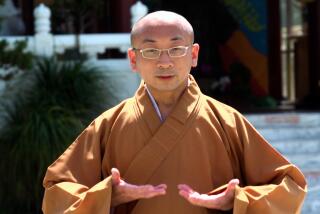In Writings, Local Buddhist Leader Claims Close Links to White House
- Share via
The Buddhist leader who approved the use of temple funds for political contributions has written a book proudly describing her encounters with President Clinton and Vice President Al Gore and featuring a cover photo of her with Clinton.
Tzu Jung--abbess of the Hsi Lai Temple where Gore attended a controversial fund-raiser last year--provides an insider’s view of contacts that have haunted the vice president and embarrassed some members of the Taiwan-based Buddhist sect.
The abbess said in her book that the temple had contacts previously with representatives of presidents Reagan ad Bush, but established a closer relationship with the Clinton administration, with exchanges of invitations and small gifts.
“He [Clinton] . . . invited me to his birthday party,” she wrote. “I also invited him to come to the temple to meet our members. He gladly accepted.” There is no mention of a planned Clinton visit to the temple in Democratic National Committee or White House schedules for that day, however.
Tzu Jung, whose given name is Suh Wen-Jen, approved the temple’s political contributions surrounding the Gore event, according to documents and the testimony of temple nuns appearing before a congressional committee. She also was one of the temple officials and devotees whose donations to the DNC were repaid from temple funds.
But her glowing account touts her White House contacts as important public relations successes without delving into the temple’s political contributions or the fund-raising controversy.
Her book, “My Observations of Americans,” was published in November in Taiwan by a company affiliated with the temple--a month after the temple emerged in the controversy.
The book was sent to temples all over the world as a gift to devotees, according to Jung’s attorney, Brian Sun of Santa Monica. No sales records are available, he said, because the book is not routinely sold. Donations are requested.
During a Democratic Party fund-raiser in Century City on July 22, 1996, the abbess sat at the head table with Clinton, Indonesian businessman Ted Sioeng--whose family contributed $250,000 to the DNC--and James T. Riady, a Clinton friend and contributor whose Indonesian family owns the giant Lippo Group conglomerate.
The abbess said “it was planned” that she was to see Clinton at the temple on the day of the Century Plaza Hotel event, but his other appointments that day required her to go to the hotel to see him. Accompanying her was Maria L. Hsia, a temple consultant and fund-raiser who has figured prominently in the campaign-finance controversy.
When she met Clinton at the hotel, Tzu Jung said he praised the temple as “one of the most solemn structures in the Western Hemisphere,” and affirmed its “important role as a channel of East-West cultural exchange.”
Her recollection makes it appear as if she saw the president privately, but her attorney said she only saw him during the VIP photo-opportunity reception for contributors.
The abbess also wrote that she was invited to the Clinton White House on several occasions. “But due to mutual scheduling conflicts, we missed several presidential breakfasts and the presidential inauguration,” she wrote.
Tzu Jung said she met Gore three times. Prominently featured in her book is a picture of Gore greeting her and other nuns during his April 29, 1996, visit to the temple.
The vice president’s demeanor and familiarity with Buddhism won praise from everyone, she recalled. She presented him with a “lotus lamp” to take to the president, hoping that the “Light of America” would shine over the world.
Tzu Jung described Gore’s Hsi Lai Temple luncheon as a “noteworthy event” but not because of “his high position.” Rather, she said, it was special because, even though he is a Christian, Gore made a gesture that conveyed Buddhist meanings.
“As soon as Mr. Gore entered the gate, he brought together his palms,” she wrote.
“He thought the closed palm symbolized the merging of fingers, long and short ones, thus racial harmony and tolerance--the founding ideals of America.”
The abbess stated that of all the American presidents, she believes Clinton values Asians the most.
“Every time President Clinton visits Southern California, he always wants to visit the temple,” she wrote.
“Thus far, he has not been able to due to his schedule. Even so, the temple frequently receives small gifts from the White House. President Clinton has invited us to visit the White House several times.”
Times staff writer William C. Rempel contributed to this story.
More to Read
Get the L.A. Times Politics newsletter
Deeply reported insights into legislation, politics and policy from Sacramento, Washington and beyond. In your inbox twice per week.
You may occasionally receive promotional content from the Los Angeles Times.








